BBC Earth newsletter
BBC Earth delivered direct to your inbox
Sign up to receive news, updates and exclusives from BBC Earth and related content from BBC Studios by email.

Black widow spiders have risen to fame for their penchant for eating their mate. While most widows are not to be messed with, there’s more to them than meets the eye.
Black widows are widely known for their penchant for snacking on their mate after reproduction and packing a real venomous punch in each bite. Widows are indeed formidable hunters, some species do eat their lovers, and yes, their venom is highly toxic. However, widow spiders aren’t quite so one-dimensional: they are also doting parents, master silk producers, and are actually rather timid and even clumsy. Crucially, they aren’t just one thing: they vary widely from species to species, each having evolved special tricks up their eight legs.
|
The black widow spider is a type of spider from the genus Latrodectus, which includes over 30 species collectively known as “widows”. While most are black widows, some are red widows, brown widows, and others.

The various species of black widow spiders are roughly grouped according to where in the world they’re found: European black widows, South American black widows, North American black widows, African and Madagascan black widows, Asian black widows and Australian ones.1
Studies state, however, that the classification of black widow spiders has suffered “a chaotic history”, because scientists long struggled to make sense of the differences and similarities between black widows around the world.2
Black widow spiders are small spiders with big rounded, globe-like bellies. Female black widow spiders are typically a deep shiny black colour with red, orange or yellow markings on their abdomen.3 These markings can take the shape of an hourglass, two moon crescents back-to-back, small triangles, or spots.
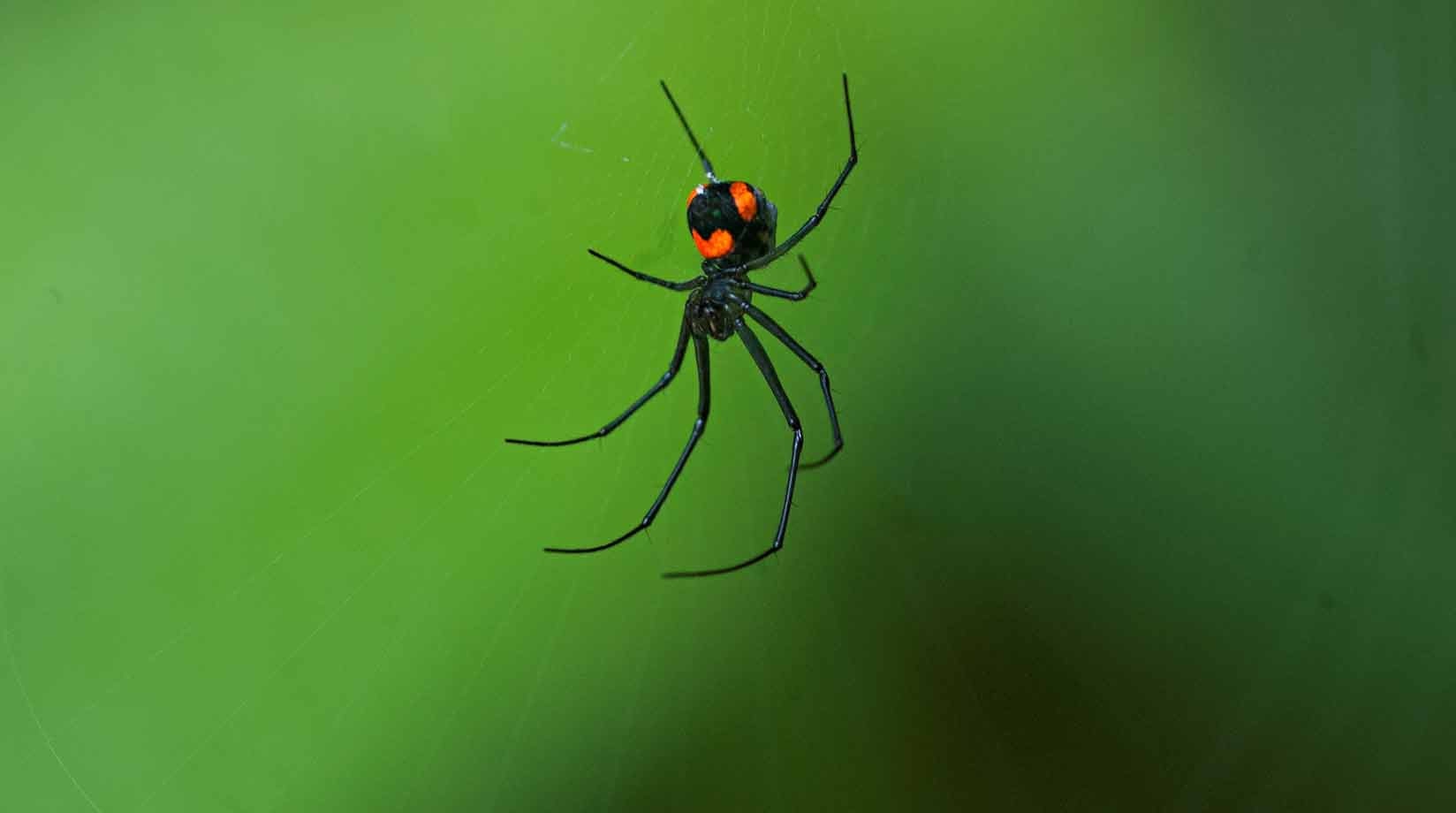
Male black widow spiders don’t just come in black, but also greys, browns, and reds, depending on the species. Some also present with yellow or red bands on their sides too. Baby black widows are pale white and yellow in colour.
Size, again, depends on species, but females are about 3cm long from tip to toe, while males are much smaller, reaching a maximum of half the female’s length. Females are roughly the size of large marbles, whereas males resemble grains of rice.
While redback spiders are sometimes dubbed the black widows of Australia, they are not strictly the same species as the traditional “black widow”. Atop the abdomen marking, redbacks also have a red stripe on their back, as their name suggests.4
There is also a group of spiders known as “false widow spiders” which resemble black widows but belong to a completely different genus, the Steatoda.5 These spiders likely evolved to look like widows to fool predators and avoid being seen as food.
Several animals use colours to warn their predators that they’re not to be messed with, because bright colours suggest danger, while still striking a balance of not being too obvious to prey.6
Research on black widow spiders suggests that the markings on their abdomen have evolved large enough to be spotted by predator birds above and ward them off. When one scientist made several 3D-printed widows – some with red markings, some with nothing – and placed them in a bird feeder, the beaked predators ate the unmarked spiders three times more often.7
 Research suggests that the markings on their abdomen have evolved large enough to be spotted by predator birds above and ward them off © Sari O'Neal | Shutterstock
Research suggests that the markings on their abdomen have evolved large enough to be spotted by predator birds above and ward them off © Sari O'Neal | Shutterstock
Widow spiders are found the world over – from Europe to Africa, from Asia to America and Oceania, with the exception of Antarctica.8
Not only are there different species that have adapted to different areas of the world, but human travel and commerce have helped these arachnids spread and conquer new locations. Black widows have even been intercepted at ports hitching a ride with imported goods. It’s this way that several species of black widows were accidentally introduced to the scattered, remote islands of Hawaii in the 80s.9 Climate change may also be affecting their distribution, as studies suggest that warmer temperatures are enabling black widows to expand further north, making previously too-cold locations more hospitable.10
Widows can be found in diverse environments, from hot, arid deserts to humid tropical forests, agricultural areas, and cities. They typically build cobwebs close to the ground, in secluded nooks and crannies under ledges, rocks, and plants. They often make their nests in pre-existing holes in dark, undisturbed areas.
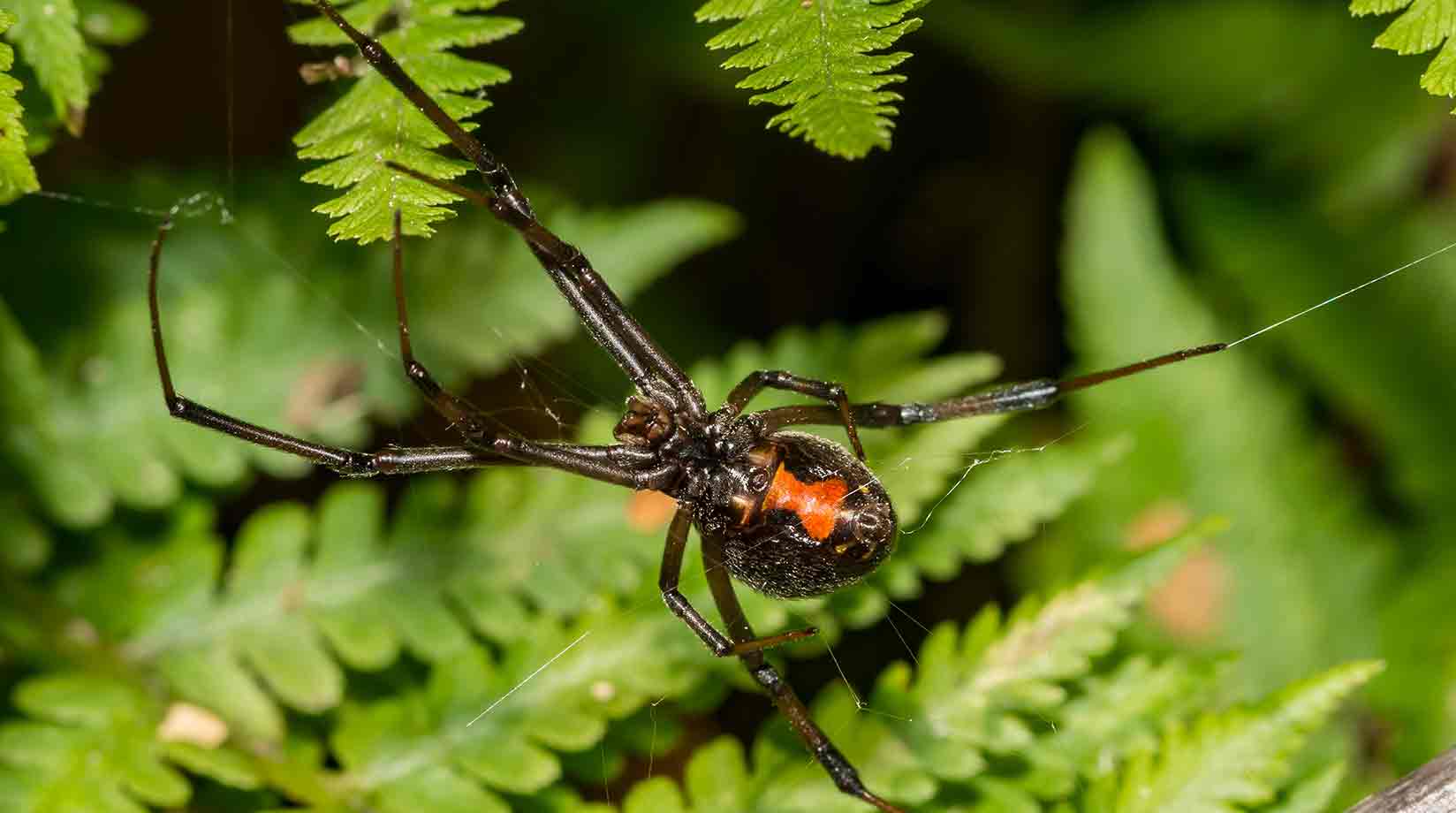
The black widow gets its name because the female spiders are thought to habitually eat the male spider after reproducing.11 This is likely not as common in nature as the name suggests. But the moniker’s mysterious and seductive appeal has led to it being used to describe everything from athletes and superheroes to several female murderers.12
Yes, they do. Black widows are part of a family of spiders that makes cobwebs: irregular, mesh-like webs that look a little messy from the outside. They like to make their homes in corners and hidden dark nooks and crannies, and studies suggest they don’t tend to change or adapt their cobwebs much, regardless of what’s happening around them.13 Yet when researchers in 2020 had several black widows compete against each, making them kick each other out of their webs, black widows that built more silk structural lines in their cobwebs were more successful in defending their webs against intruders from their same species.14
This web is used for everything from a home to sleep in to ensnaring prey, mating and bundling up their eggs.15 Females spend most of their time hanging upside down from their webs, making sure predators from above can see their red warning symbols on their belly.
Spider silk is also super strong. Research from the 90s had already suggested that black widow spider silk is as durable as Kevlar, the material used to make bulletproof jackets.
No, black widows aren’t aggressive. Like most spiders, they only bite if they feel threatened or cornered. The risk of a defensive bite is extremely low outside of very specific situations, according to arachnologist Catherine Scott from McGill University, in Canada. For instance, a black widow trapped between shoes or clothing and your body is likely to bite defensively because it has no other options for defence or escape.
A female black widow may also bite to defend herself and her offspring if she is guarding egg sacs and feels threatened, as she is highly motivated to protect her young. However, this would require someone getting really close to the widow’s nest, which is unlikely to happen accidentally, since widows typically live in places like rodent burrows or under rocks or logs, says Scott. “Even where black widows are extremely abundant people rarely encounter them.”
“They will not jump or 'attack' a person. They are very clumsy when not in their webs,” says Scott. Widows don't like to leave their webs unless subjected to a major disturbance like flooding or destruction of their web. “Even when you are near black widows, they are not interested in bothering you.”
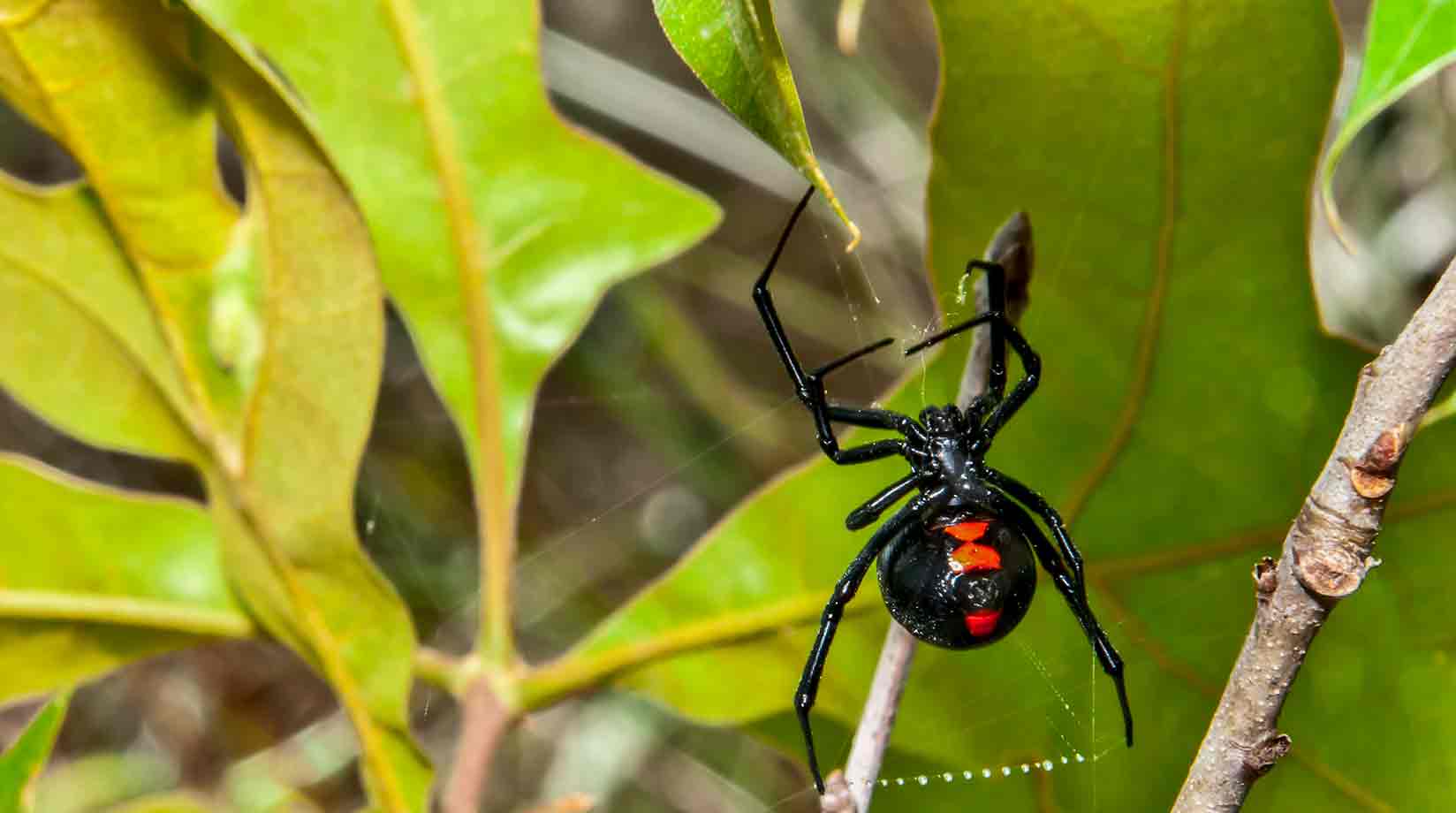
Black widow spiders are not poisonous because they’re not covered in toxins; they're not toxic to the touch or if ingested. They are, however, venomous: they can inject toxins into their prey through specialised biting fangs in their mouth.
The venom of black widows is highly toxic. Like most spider venoms, it is designed to neutralise insects and other arachnids. But black widow toxin, known as latrotoxin, also has chemical markers that target crustaceans and even vertebrates, which is unusual in spiders, says Maydianne Andrade, a black widow spider researcher at the University of Toronto, in Canada. “We think maybe this venom did evolve in a context where you had to be able to eat whatever food was available,” says Andrade. Still, widow venom is not meant to kill humans.
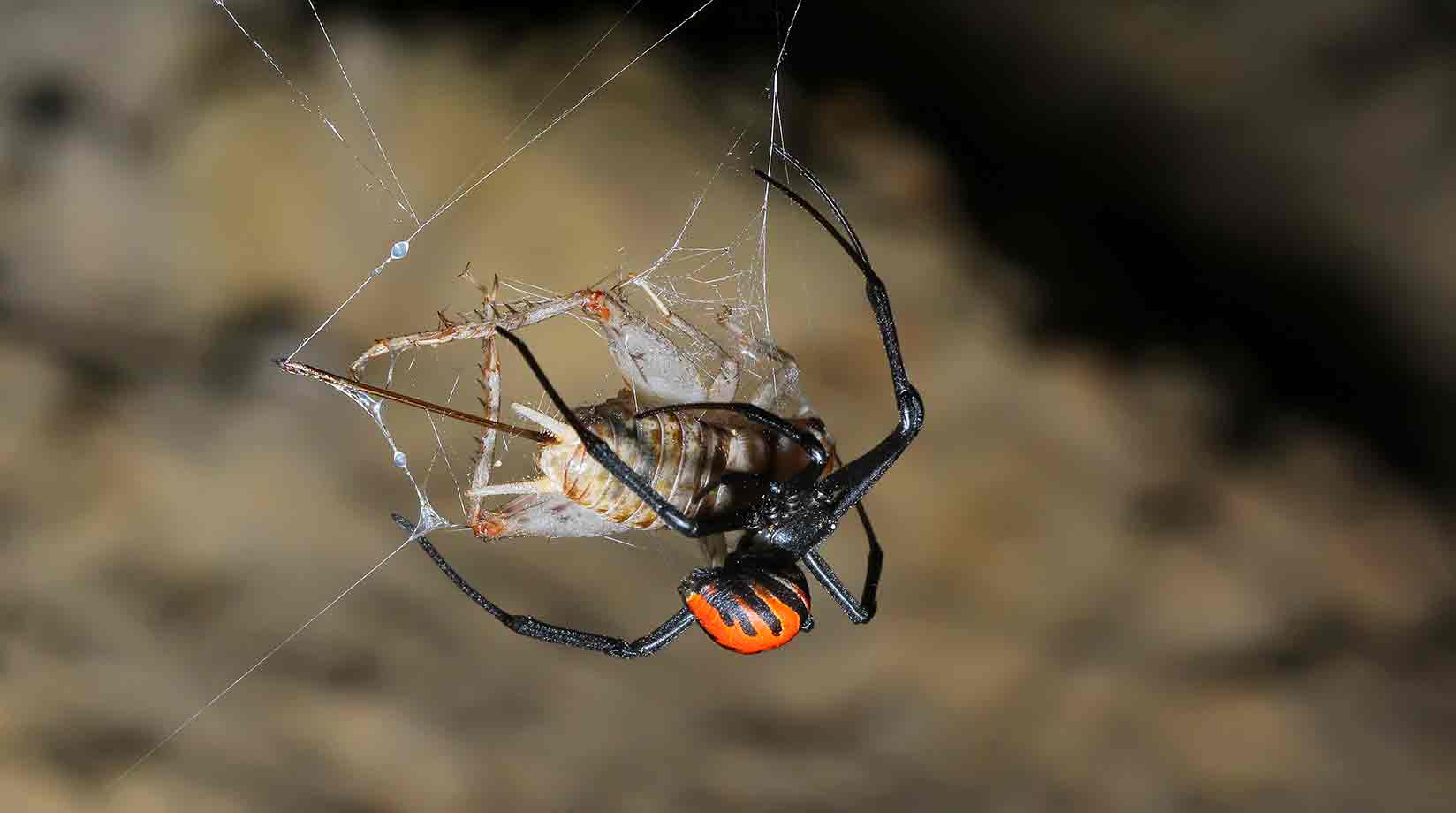
Widow venom is “definitely in the top 10 in terms of venoms that humans have to care about,” says Maydianne Andrade, a scientist who studies black widow spiders. But the venom is not designed to kill humans.
When one of her research colleagues was bitten, Andrade says they described it as the worst flu they’d ever had. “A week afterward they were still waking up in the night, drenched in sweat, all their joints were aching,” says Andrade. The venom causes muscle pain, nausea, and aches. Bites can be fatal to children, the elderly or people who already have compromised health, but there are very few recorded deaths from widow bites across Europe, South Africa and North America.16
If you’re bitten by a widow spider, it is advised you go to hospital immediately. Most hospitals have a serum that can counteract the venom, alleviate the symptoms and reduce the risk of mortality.
The antivenom serum was developed by exposing horses to widow venom and then extracting the antibodies they produced. However, as there is evidence that not everyone reacts well to this type of antivenom, the antidote is typically reserved for patients who are at high risk.
Black widow spiders eat insects – like flies, cockroaches, beetles, ants and woodlice – smaller spider species, and sometimes other black widows.17 In the field, they’ve also been observed eating small snakes and lizards too, says Maydianne Andrade, a black widow spider researcher at the University of Toronto, Canada.
They sense prey through vibrations on their web. Once the prey is stuck, the spider wraps it up in a bundle of silk so it is immobilised and easy to snack on, and then delivers a deadly toxic bite to paralyse it.18
Like all spiders, black widows don’t chew their food: they puncture prey with their fangs and then vomit out a bunch of enzymes over it, waiting for those digestive fluids to break down and liquefy their prey before slurping it all up.19
How black widows mate varies from species to species. Generally, adult males are drawn in by a female’s pheromones: chemical signals that communicate various messages, including the female’s readiness to mate. These pheromones, scientists think, can help males also identify whether a widow female is hungry and potentially dangerous to approach.20 Research also suggests male widows sometimes track down potential females by following silk trails left by other male widows before them.21
Once a male enters the female’s web, courtship begins – a process that can last for hours.
For some species, like the Western widow that lives in Texas, this courting method includes spinning a silk hammock around the female to hold her – something known as the bridal veil.22 Some scientists speculate this is a constraint on the female that slows her down if she's trying to attack the male; others suggest there’s a chemical signal released by the pheromones on the silk that persuades the females to mate.
“Females get a lot of information about males from their courtship. They bounce around on the web and produce vibrational signals, but they also get information from the chemicals produced by a male on his body or in his silk,” says Maydianne Andrade, a scientist who studies black widow spiders.
After mating, the male may get away and mate with several other females, or it may end up ensnared by the female and eaten.
Black widows get their moniker from the female’s penchant for snacking on their male mates after reproduction. While it was thought that black widows ended up in this gruesome love story – called sexual cannibalism – every single time, scientists now largely believe this behaviour is not as common as once thought and that it varies between species.
For some species, cannibalism hasn’t really ever been recorded, while for others, cannibalism seems almost mandatory. The American Western black widow will kill the male when he’s approaching her if she’s hungry, but not if she’s well fed, says Andrade.
For the Australian redback (considered to be the Australian black widow), males actually move their whole body over the female's fangs while they are in the act of copulating, and females begin to eat them right there and then. “Death of the male from cannibalism in that species is about 60%,” says Maydianne Andrade, a scientist who studies black widow spiders. In her research, Andrade argues that males evolved this strategy because many will die while searching for a mate.23 By sacrificing themselves to their partner during mating, they ensure a guaranteed opportunity to reproduce.
Studies on the Mediterranean widow show that the smaller the difference between male and female body size, the more likely a female is to attack and slurp up the mate. 24
After mating, females produce a cocoon of silk that looks like a cotton ball with a very tight outer covering, and deposits her eggs inside for protection.25
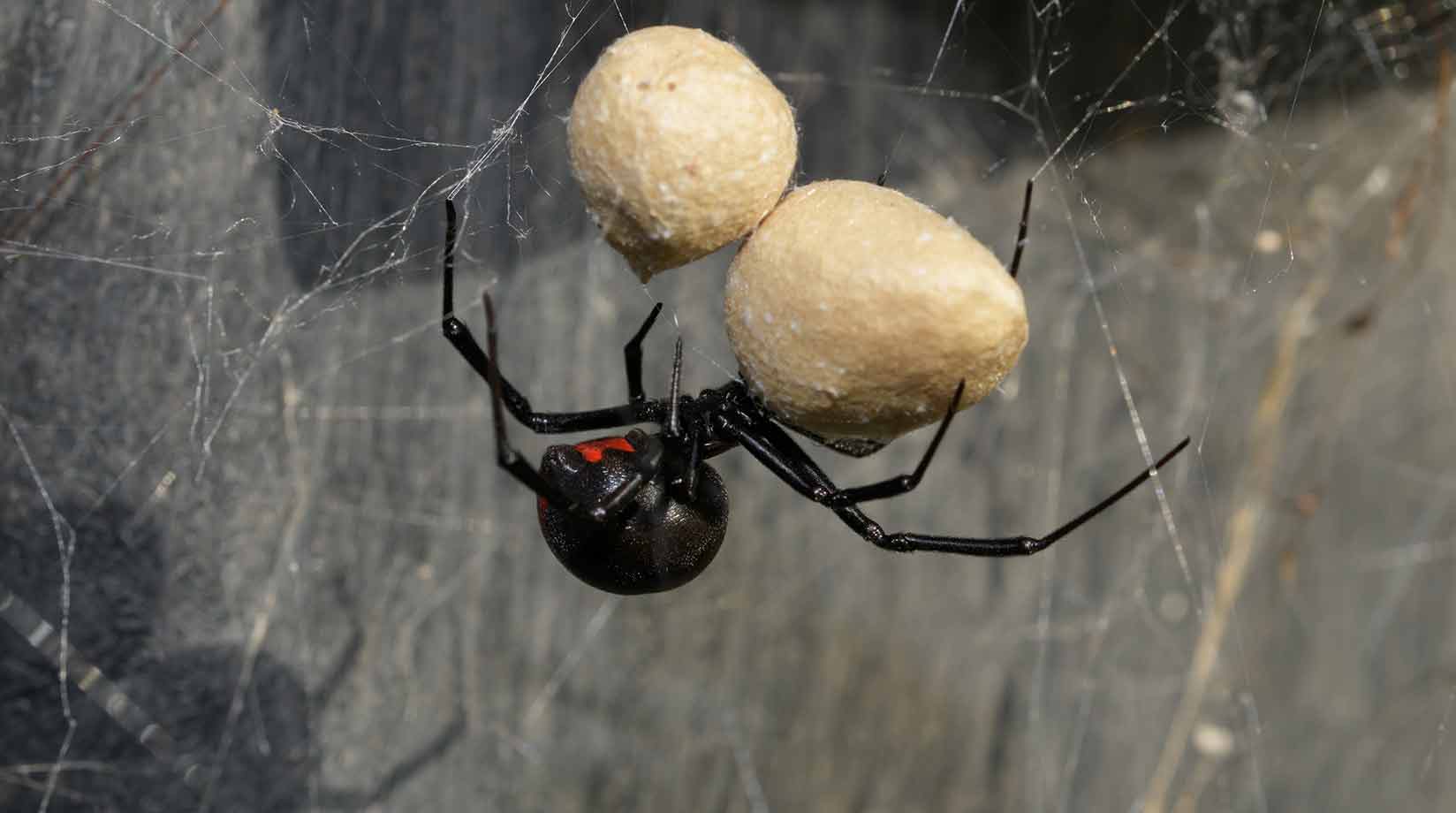
“Depending on the species, there may be 90 to 400 eggs inside each egg sac,” says Maydianne Andrade, a scientist who studies black widow spiders. In laboratory settings, females produce between one and four egg sacs per month for up to two years after mating. Remarkably, they can fertilise thousands of eggs using sperm from just one act of mating. “So females definitely live for really long after mating [especially for] a little, tiny spider,” says Andrade, who estimates their life-span to be at least two years post-mating.
The baby spiders, which are tiny, spindly and orange-and-white, emerge between two weeks and a month after the silk cocoon has been made. Sometimes the spiderlings cannibalise each other after hatching.
And surprisingly, “black widow females are actually really maternal”, says Andrade. Females hold their egg sacks close, move them to sunny spots during the day and take them back to their refuge at night. “The only time we find that they're aggressive is if you're trying to take their egg sacs.”
Black widows don’t hibernate in the scientific sense – the way mammals slow down their metabolism – but they do seek refuge during cold months and enter a state that arachnologists refer to as “overwintering.”
While overwintering, they reduce the water content in their body so that it contains less water that might freeze. They also build a really thick webbing inside their refuges, which are often located deep underground, in crevices, or among rocks warmed by the sun, says arachnologist Maydianne Andrade. In general, widows are very cold-tolerant, and those reared in Andrade’s laboratory at the University of Toronto, where she specialises in studying black widows, sometimes spend days in a fridge with no ill effect.
In 2024, scientists even found, for the first time, widows who survived the frigid winters of Patagonia.26
No. Black widow species are fairly common and they are not at risk of extinction.
However, scientists have observed a new trend in southern North America where their brown widow counterparts are outcompeting them.27This interspecies competition has caused some local extinctions of black widows in the area.
Featured image © Jay Ondreicka | Shutterstock
Fun fact image © Tom Sid | Unsplash
Quick facts:
Interviews:
An interview with Maydianne Andrade, a black widow spider researcher at the University of Toronto, in Canada, was conducted over Zoom in October 2024. More about Dr. Andrade: https://www.utsc.utoronto.ca/biosci/maydianne-andrade
An interview with Catherine Scott from McGill University, in Canada, was conducted over email in October 2024. More about Dr. Scott: https://smallpondscience.com/about-2/about-catherine-scott/
Fact File:
Black widow spiders have risen to fame for their penchant for eating their mate. While most widows are not to be messed with, there’s more to them than meets the eye.
Spiderlings
Cluster, clutter
Mainly insects like mosquitoes, flies, beetles, cockroaches, other spiders and also small vertebrates
Birds, reptiles, mammals, other arachnids, blue mud dauber wasp2
1 to 3 years
Average of 3.5cm in females, like large marbles, and 1.5cm in males, like grains of rice
Both males and females weigh less than a gram, but females weigh 10-160 times as much as males.
From hot and arid deserts to humid tropical forests, agricultural areas, and cities.3
N/A
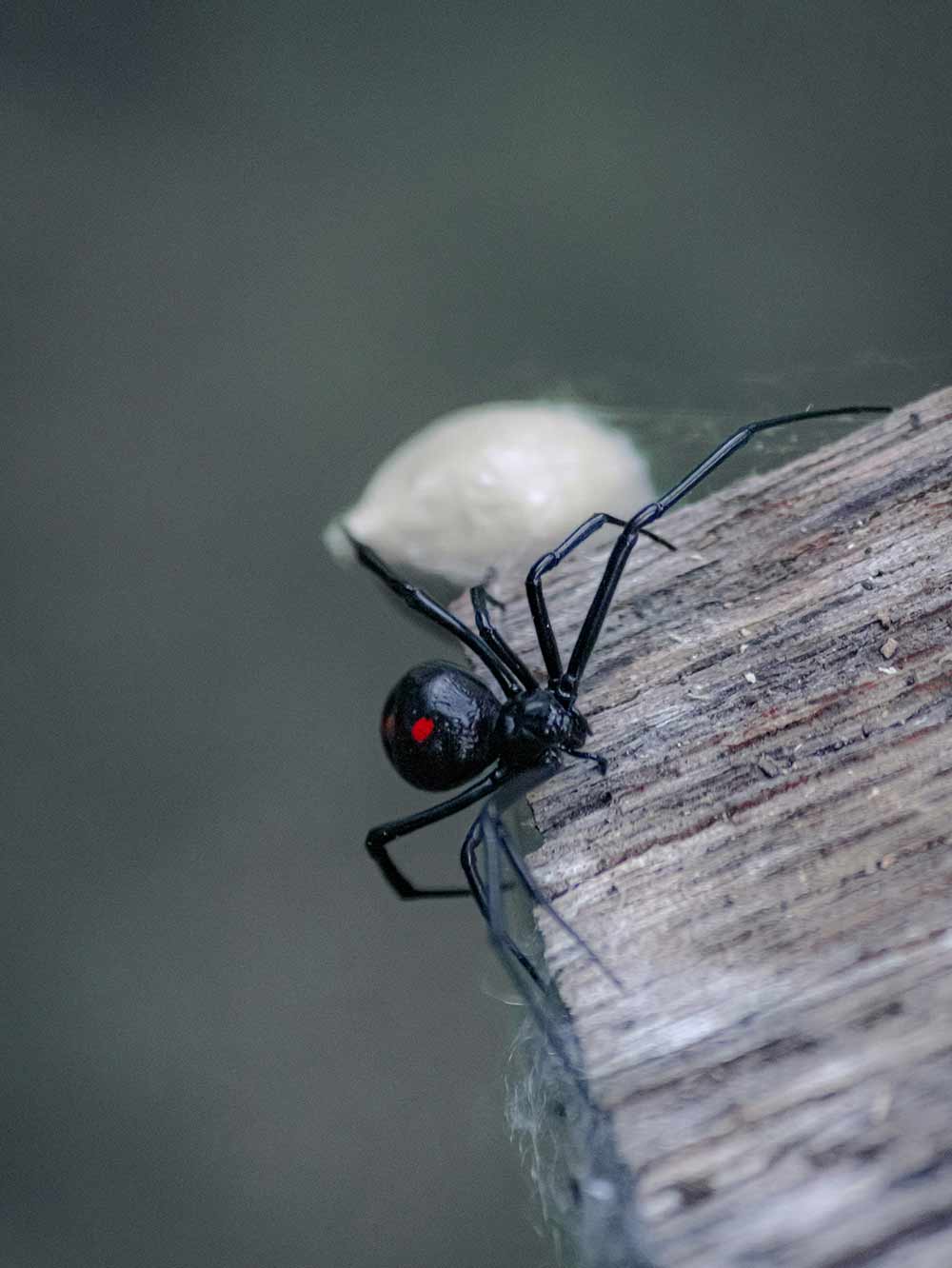
Black widow venom is very powerful, though in most cases it is not deadly to humans.
Black widows are widely known for their penchant for snacking on their mate after reproduction and packing a real venomous punch in each bite. Widows are indeed formidable hunters, some species do eat their lovers, and yes, their venom is highly toxic. However, widow spiders aren’t quite so one-dimensional: they are also doting parents, master silk producers, and are actually rather timid and even clumsy. Crucially, they aren’t just one thing: they vary widely from species to species, each having evolved special tricks up their eight legs.
|
The black widow spider is a type of spider from the genus Latrodectus, which includes over 30 species collectively known as “widows”. While most are black widows, some are red widows, brown widows, and others.

The various species of black widow spiders are roughly grouped according to where in the world they’re found: European black widows, South American black widows, North American black widows, African and Madagascan black widows, Asian black widows and Australian ones.1
Studies state, however, that the classification of black widow spiders has suffered “a chaotic history”, because scientists long struggled to make sense of the differences and similarities between black widows around the world.2
Black widow spiders are small spiders with big rounded, globe-like bellies. Female black widow spiders are typically a deep shiny black colour with red, orange or yellow markings on their abdomen.3 These markings can take the shape of an hourglass, two moon crescents back-to-back, small triangles, or spots.

Male black widow spiders don’t just come in black, but also greys, browns, and reds, depending on the species. Some also present with yellow or red bands on their sides too. Baby black widows are pale white and yellow in colour.
Size, again, depends on species, but females are about 3cm long from tip to toe, while males are much smaller, reaching a maximum of half the female’s length. Females are roughly the size of large marbles, whereas males resemble grains of rice.
While redback spiders are sometimes dubbed the black widows of Australia, they are not strictly the same species as the traditional “black widow”. Atop the abdomen marking, redbacks also have a red stripe on their back, as their name suggests.4
There is also a group of spiders known as “false widow spiders” which resemble black widows but belong to a completely different genus, the Steatoda.5 These spiders likely evolved to look like widows to fool predators and avoid being seen as food.
Several animals use colours to warn their predators that they’re not to be messed with, because bright colours suggest danger, while still striking a balance of not being too obvious to prey.6
Research on black widow spiders suggests that the markings on their abdomen have evolved large enough to be spotted by predator birds above and ward them off. When one scientist made several 3D-printed widows – some with red markings, some with nothing – and placed them in a bird feeder, the beaked predators ate the unmarked spiders three times more often.7
 Research suggests that the markings on their abdomen have evolved large enough to be spotted by predator birds above and ward them off © Sari O'Neal | Shutterstock
Research suggests that the markings on their abdomen have evolved large enough to be spotted by predator birds above and ward them off © Sari O'Neal | Shutterstock
Widow spiders are found the world over – from Europe to Africa, from Asia to America and Oceania, with the exception of Antarctica.8
Not only are there different species that have adapted to different areas of the world, but human travel and commerce have helped these arachnids spread and conquer new locations. Black widows have even been intercepted at ports hitching a ride with imported goods. It’s this way that several species of black widows were accidentally introduced to the scattered, remote islands of Hawaii in the 80s.9 Climate change may also be affecting their distribution, as studies suggest that warmer temperatures are enabling black widows to expand further north, making previously too-cold locations more hospitable.10
Widows can be found in diverse environments, from hot, arid deserts to humid tropical forests, agricultural areas, and cities. They typically build cobwebs close to the ground, in secluded nooks and crannies under ledges, rocks, and plants. They often make their nests in pre-existing holes in dark, undisturbed areas.

The black widow gets its name because the female spiders are thought to habitually eat the male spider after reproducing.11 This is likely not as common in nature as the name suggests. But the moniker’s mysterious and seductive appeal has led to it being used to describe everything from athletes and superheroes to several female murderers.12
Yes, they do. Black widows are part of a family of spiders that makes cobwebs: irregular, mesh-like webs that look a little messy from the outside. They like to make their homes in corners and hidden dark nooks and crannies, and studies suggest they don’t tend to change or adapt their cobwebs much, regardless of what’s happening around them.13 Yet when researchers in 2020 had several black widows compete against each, making them kick each other out of their webs, black widows that built more silk structural lines in their cobwebs were more successful in defending their webs against intruders from their same species.14
This web is used for everything from a home to sleep in to ensnaring prey, mating and bundling up their eggs.15 Females spend most of their time hanging upside down from their webs, making sure predators from above can see their red warning symbols on their belly.
Spider silk is also super strong. Research from the 90s had already suggested that black widow spider silk is as durable as Kevlar, the material used to make bulletproof jackets.
No, black widows aren’t aggressive. Like most spiders, they only bite if they feel threatened or cornered. The risk of a defensive bite is extremely low outside of very specific situations, according to arachnologist Catherine Scott from McGill University, in Canada. For instance, a black widow trapped between shoes or clothing and your body is likely to bite defensively because it has no other options for defence or escape.
A female black widow may also bite to defend herself and her offspring if she is guarding egg sacs and feels threatened, as she is highly motivated to protect her young. However, this would require someone getting really close to the widow’s nest, which is unlikely to happen accidentally, since widows typically live in places like rodent burrows or under rocks or logs, says Scott. “Even where black widows are extremely abundant people rarely encounter them.”
“They will not jump or 'attack' a person. They are very clumsy when not in their webs,” says Scott. Widows don't like to leave their webs unless subjected to a major disturbance like flooding or destruction of their web. “Even when you are near black widows, they are not interested in bothering you.”

Black widow spiders are not poisonous because they’re not covered in toxins; they're not toxic to the touch or if ingested. They are, however, venomous: they can inject toxins into their prey through specialised biting fangs in their mouth.
The venom of black widows is highly toxic. Like most spider venoms, it is designed to neutralise insects and other arachnids. But black widow toxin, known as latrotoxin, also has chemical markers that target crustaceans and even vertebrates, which is unusual in spiders, says Maydianne Andrade, a black widow spider researcher at the University of Toronto, in Canada. “We think maybe this venom did evolve in a context where you had to be able to eat whatever food was available,” says Andrade. Still, widow venom is not meant to kill humans.

Widow venom is “definitely in the top 10 in terms of venoms that humans have to care about,” says Maydianne Andrade, a scientist who studies black widow spiders. But the venom is not designed to kill humans.
When one of her research colleagues was bitten, Andrade says they described it as the worst flu they’d ever had. “A week afterward they were still waking up in the night, drenched in sweat, all their joints were aching,” says Andrade. The venom causes muscle pain, nausea, and aches. Bites can be fatal to children, the elderly or people who already have compromised health, but there are very few recorded deaths from widow bites across Europe, South Africa and North America.16
If you’re bitten by a widow spider, it is advised you go to hospital immediately. Most hospitals have a serum that can counteract the venom, alleviate the symptoms and reduce the risk of mortality.
The antivenom serum was developed by exposing horses to widow venom and then extracting the antibodies they produced. However, as there is evidence that not everyone reacts well to this type of antivenom, the antidote is typically reserved for patients who are at high risk.
Black widow spiders eat insects – like flies, cockroaches, beetles, ants and woodlice – smaller spider species, and sometimes other black widows.17 In the field, they’ve also been observed eating small snakes and lizards too, says Maydianne Andrade, a black widow spider researcher at the University of Toronto, Canada.
They sense prey through vibrations on their web. Once the prey is stuck, the spider wraps it up in a bundle of silk so it is immobilised and easy to snack on, and then delivers a deadly toxic bite to paralyse it.18
Like all spiders, black widows don’t chew their food: they puncture prey with their fangs and then vomit out a bunch of enzymes over it, waiting for those digestive fluids to break down and liquefy their prey before slurping it all up.19
How black widows mate varies from species to species. Generally, adult males are drawn in by a female’s pheromones: chemical signals that communicate various messages, including the female’s readiness to mate. These pheromones, scientists think, can help males also identify whether a widow female is hungry and potentially dangerous to approach.20 Research also suggests male widows sometimes track down potential females by following silk trails left by other male widows before them.21
Once a male enters the female’s web, courtship begins – a process that can last for hours.
For some species, like the Western widow that lives in Texas, this courting method includes spinning a silk hammock around the female to hold her – something known as the bridal veil.22 Some scientists speculate this is a constraint on the female that slows her down if she's trying to attack the male; others suggest there’s a chemical signal released by the pheromones on the silk that persuades the females to mate.
“Females get a lot of information about males from their courtship. They bounce around on the web and produce vibrational signals, but they also get information from the chemicals produced by a male on his body or in his silk,” says Maydianne Andrade, a scientist who studies black widow spiders.
After mating, the male may get away and mate with several other females, or it may end up ensnared by the female and eaten.
Black widows get their moniker from the female’s penchant for snacking on their male mates after reproduction. While it was thought that black widows ended up in this gruesome love story – called sexual cannibalism – every single time, scientists now largely believe this behaviour is not as common as once thought and that it varies between species.
For some species, cannibalism hasn’t really ever been recorded, while for others, cannibalism seems almost mandatory. The American Western black widow will kill the male when he’s approaching her if she’s hungry, but not if she’s well fed, says Andrade.
For the Australian redback (considered to be the Australian black widow), males actually move their whole body over the female's fangs while they are in the act of copulating, and females begin to eat them right there and then. “Death of the male from cannibalism in that species is about 60%,” says Maydianne Andrade, a scientist who studies black widow spiders. In her research, Andrade argues that males evolved this strategy because many will die while searching for a mate.23 By sacrificing themselves to their partner during mating, they ensure a guaranteed opportunity to reproduce.
Studies on the Mediterranean widow show that the smaller the difference between male and female body size, the more likely a female is to attack and slurp up the mate. 24
After mating, females produce a cocoon of silk that looks like a cotton ball with a very tight outer covering, and deposits her eggs inside for protection.25

“Depending on the species, there may be 90 to 400 eggs inside each egg sac,” says Maydianne Andrade, a scientist who studies black widow spiders. In laboratory settings, females produce between one and four egg sacs per month for up to two years after mating. Remarkably, they can fertilise thousands of eggs using sperm from just one act of mating. “So females definitely live for really long after mating [especially for] a little, tiny spider,” says Andrade, who estimates their life-span to be at least two years post-mating.
The baby spiders, which are tiny, spindly and orange-and-white, emerge between two weeks and a month after the silk cocoon has been made. Sometimes the spiderlings cannibalise each other after hatching.
And surprisingly, “black widow females are actually really maternal”, says Andrade. Females hold their egg sacks close, move them to sunny spots during the day and take them back to their refuge at night. “The only time we find that they're aggressive is if you're trying to take their egg sacs.”
Black widows don’t hibernate in the scientific sense – the way mammals slow down their metabolism – but they do seek refuge during cold months and enter a state that arachnologists refer to as “overwintering.”
While overwintering, they reduce the water content in their body so that it contains less water that might freeze. They also build a really thick webbing inside their refuges, which are often located deep underground, in crevices, or among rocks warmed by the sun, says arachnologist Maydianne Andrade. In general, widows are very cold-tolerant, and those reared in Andrade’s laboratory at the University of Toronto, where she specialises in studying black widows, sometimes spend days in a fridge with no ill effect.
In 2024, scientists even found, for the first time, widows who survived the frigid winters of Patagonia.26
No. Black widow species are fairly common and they are not at risk of extinction.
However, scientists have observed a new trend in southern North America where their brown widow counterparts are outcompeting them.27This interspecies competition has caused some local extinctions of black widows in the area.
Featured image © Jay Ondreicka | Shutterstock
Fun fact image © Tom Sid | Unsplash
Quick facts:
Interviews:
An interview with Maydianne Andrade, a black widow spider researcher at the University of Toronto, in Canada, was conducted over Zoom in October 2024. More about Dr. Andrade: https://www.utsc.utoronto.ca/biosci/maydianne-andrade
An interview with Catherine Scott from McGill University, in Canada, was conducted over email in October 2024. More about Dr. Scott: https://smallpondscience.com/about-2/about-catherine-scott/
Fact File:
Spiderlings
Cluster, clutter
Mainly insects like mosquitoes, flies, beetles, cockroaches, other spiders and also small vertebrates
Birds, reptiles, mammals, other arachnids, blue mud dauber wasp2
1 to 3 years
Average of 3.5cm in females, like large marbles, and 1.5cm in males, like grains of rice
Both males and females weigh less than a gram, but females weigh 10-160 times as much as males.
From hot and arid deserts to humid tropical forests, agricultural areas, and cities.3
N/A

Black widow venom is very powerful, though in most cases it is not deadly to humans.